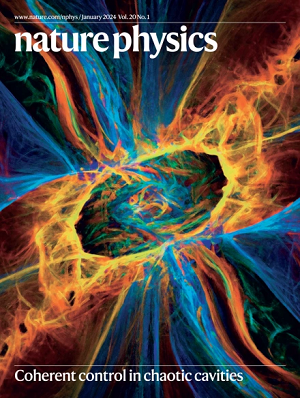Dominant 1/3-filling correlated insulator states and orbital geometric frustration in twisted bilayer graphene
IF 18.4
1区 物理与天体物理
Q1 PHYSICS, MULTIDISCIPLINARY
引用次数: 0
Abstract
Geometric frustration occurs in a lattice system when not all the interactions can be satisfied simultaneously. The simplest example is antiferromagnetically coupled spins on a triangular lattice. Frustrated systems are characterized by having many nearly degenerate ground states, leading to non-trivial phases, such as spin ice and spin liquids. To date, most studies have looked at geometric frustration of spins whereas orbital geometric frustration has been much less explored. For electrons in twisted bilayer graphene, when the electronic bands are filled to a fraction with denominator 3, Coulomb interactions and the Wannier orbital shapes are predicted to strongly constrain spatial charge ordering, leading to geometrically frustrated ground states that produce a new class of correlated insulating states. Here we report the observation of dominant, denominator 3, fractional-filling, insulating states in large-angle twisted bilayer graphene. These states persist in magnetic fields and display magnetic ordering signatures and tripled unit cell reconstruction. These results are in agreement with a strong-coupling theory for symmetry-breaking in geometrically frustrated fractional states. Orbitally frustrated states have been predicted to occur in twisted bilayer graphene. Now these states have been observed for fractional filling of the electronic bands, and exhibit charge- and magnetically ordered phases.


扭曲双层石墨烯中占主导地位的 1/3 填充相关绝缘体态和轨道几何沮度
当并非所有相互作用都能同时满足时,晶格系统中就会出现几何挫折。最简单的例子是三角形晶格上的反铁磁耦合自旋。受挫系统的特点是有许多近乎退化的基态,从而导致非三相,如自旋冰和自旋液体。迄今为止,大多数研究关注的是自旋的几何沮度,而对轨道几何沮度的探索要少得多。对于扭曲双层石墨烯中的电子来说,当电子带填充到分母为 3 的部分时,库仑相互作用和万尼尔轨道形状预计会强烈限制空间电荷排序,从而导致几何挫折基态,产生一类新的相关绝缘态。在这里,我们报告了在大角度扭曲双层石墨烯中观察到的占主导地位、分母 3、分数填充的绝缘态。这些态在磁场中持续存在,并显示出磁有序特征和三倍单胞重构。这些结果与几何受挫分数态对称性破缺的强耦合理论一致。
本文章由计算机程序翻译,如有差异,请以英文原文为准。
求助全文
约1分钟内获得全文
求助全文
来源期刊

Nature Physics
物理-物理:综合
CiteScore
30.40
自引率
2.00%
发文量
349
审稿时长
4-8 weeks
期刊介绍:
Nature Physics is dedicated to publishing top-tier original research in physics with a fair and rigorous review process. It provides high visibility and access to a broad readership, maintaining high standards in copy editing and production, ensuring rapid publication, and maintaining independence from academic societies and other vested interests.
The journal presents two main research paper formats: Letters and Articles. Alongside primary research, Nature Physics serves as a central source for valuable information within the physics community through Review Articles, News & Views, Research Highlights covering crucial developments across the physics literature, Commentaries, Book Reviews, and Correspondence.
 求助内容:
求助内容: 应助结果提醒方式:
应助结果提醒方式:


